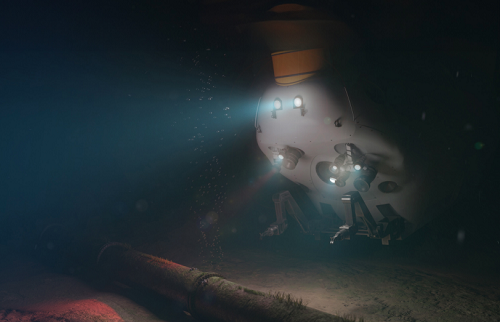Arctic Seabed Warfare Against Data Cables
by Cate Belbin
Editor: The following comments were received in response to the subject report (https://www.wilsoncenter.org/sites/default/files/media/uploads/documents/Seabed-Warfare-Cables%20%281%29.pdf).
I did an internship at the NATO Cooperative Cyber Defence Centre of Excellence (CCDCOE) last year in Tallinn, Estonia, where I worked at the law branch and wrote a draft paper on the legality of targeting undersea cables during (international) armed conflict. There are implications upon the maritime domain but also the cyber domain. I was in Estonia last year when the Chinese-owned, Hong Kong-flagged cargo vessel dragged its anchor along the seabed in the Baltic Sea, thereby damaging the Estonia-Sweden undersea cable (https://www.reuters.com/world/europe/estonia-focuses-chinese-vessel-investigation-into-underwater-cable-damage-2023-10-25/). The official story is that the crew did not know that the anchor was being dragged, but I simply do not believe that this is the case. It seems unlikely to me that a cargo ship would not feel the drag of an anchor. It should also be noted that there is no active armed conflict between the parties involved (China, Hong Kong, Estonia, Sweden) in the damage of this cable. It could be argued that China engaged in a below-threshold [threshold = Article 2(4) of the UN Charter] event in damaging the cable, thus giving rise to challenges with asymmetric threats in the maritime and cyber domains. I have no evidence to prove this point, but it is an interesting issue to ponder given the heightened cooperation between China and Russia and the geopolitics of the Baltic Sea now that Finland and Sweden are NATO member-states.
I found that undersea cables could legally be targeted as a military objective under the principle of distinction (law of armed conflict – LOAC) as they are dual-use objects (undersea cables are used for the transmission of both civilian and military/belligerent data). However, there could be questionable legality as to whether or not the targeting of an undersea cable during armed conflict would be proportional in a LOAC analysis (it depends on what cable is targeted, the states connected, the circumstances that give rise to the targeting, etc.). Whether or not there is a definite military advantage is to be determined as we lack precedent for the ‘attack’ on undersea cables during contemporary armed conflict. There is historical precedent, as nascent forms of undersea cables were severed and/or damaged during the Spanish-American War and the First World War, but these were early telegraph cables. We simply do not know what the impact would be today if a belligerent party were to destroy or otherwise damage an undersea cable during armed conflict. We could engage in an educated, speculative analysis, but this may be unnecessarily complicated absent concrete evidence of impact.
I had a conversation with someone from Supreme Headquarters Allied Powers Europe at an international law course last year in Tallinn, and I asked him about how civilians can be protected during armed conflict in the context of the direct participation in hostilities (DPH) and cable repair ships. The general principle is that civilians are protected under international humanitarian law, full stop. However, there are circumstances that arise where if civilians are directly participating in hostilities (pursuant to legal analysis/test), then they lose their protected status and can therefore legally be targetable under LOAC. I admit, this is a simplistic summary of DPH. My query arose with cable repair ships (and their crews), which are typically civilian vessels, with civilian crews, being dispatched to repair a damaged or destroyed cable/s during active hostilities. Notwithstanding the fact that cable repair crews may not be dispatched (as to not harm civilians directly or indirectly), it is an interesting question as to what could or would happen if a cable repair crew was dispatched to repair a cable damaged or destroyed by a belligerent party. To my knowledge, there is no precedent for this at present.
Furthermore, there is an interesting debate in international law right now as to whether data itself can be an ‘object’ for the purposes of targeting (https://cyberlaw.ccdcoe.org/wiki/Scenario_12:_Cyber_operations_against_computer_data#Qualification_of_data_as_an_object_under_IHL). From what I have seen, there is not much discussion on this issue in Canada. I can foresee many issues that could arise in the context of undersea cable projects in the Canadian Arctic, especially because there is a big question mark as to how these cables could or would be protected and who has jurisdiction to do so. Canada does not have a submarine capability that can operate with any degree of frequency in claimed Canadian Arctic waters, nor do we possess an intelligence-surveillance-reconnaissance capability to monitor undersea infrastructure. Recently, NATO has declared undersea cables as ‘critical undersea infrastructure’ (https://www.nato.int/cps/en/natohq/news_225582.htm), and I continue to ponder how Canada could take steps to protect undersea cables A Mari Usque Ad Mare.
There are, of course, many questions that still arise with respect to the legality of targeting undersea cables during armed conflict and there are and will inevitably be different state positions on what should be done or what could be done to protect (and defend) critical undersea infrastructure. However, we should not forget about ‘grey zone’/’below threshold’ actions that disrupt contemporary data flow and global connectedness.
Cate Belbin, B.A., J.D., LLM, is a PhD Candidate at the Schulich School of Law, Qanittaq Clean Arctic Shipping Initiative, Dalhousie University. This work is the sole opinion of the author and does not necessarily represent the views of Dalhousie University, the Royal United Services Institute of Nova Scotia, the Canadian Armed Forces or any government department or agency.
Photo: Woodrow Wilson International Center for Scholars




